Coconut Husk Hanging Planters: Craft and Benefits
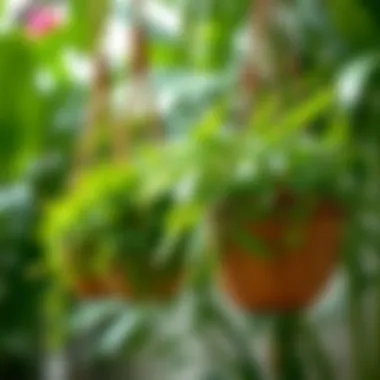
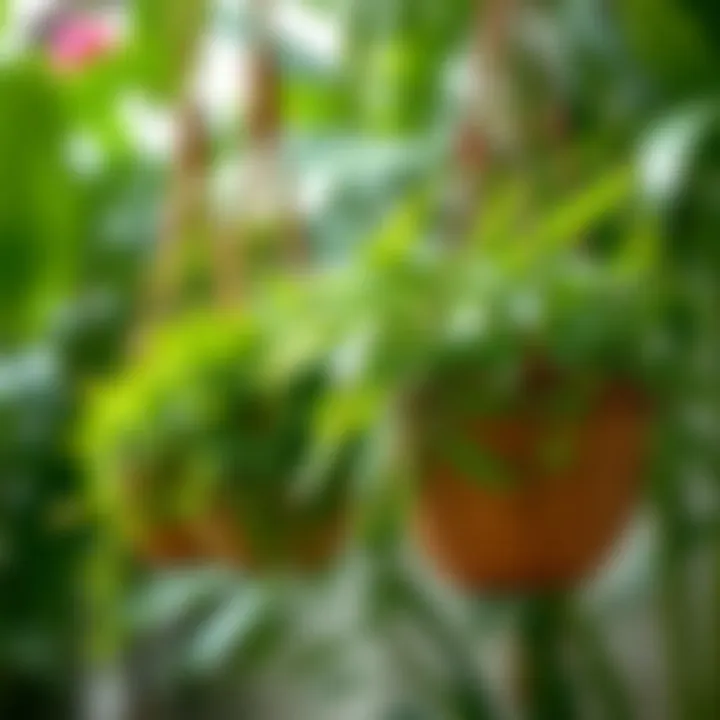
Intro
Coconut husk hanging planters are a growing trend in both indoor and outdoor gardening. These unique planters not only serve as functional gardening solutions but also bring a touch of natural beauty and sustainability to any space. Their popularity can be attributed to several factors, including the push towards eco-friendly materials, a desire for aesthetically pleasing decorations, and a keen interest in innovative gardening techniques. In this exploration, we will dissect everything from the craftsmanship behind these planters to their practical applications, allowing you to appreciate their multifaceted nature.
The essence of coconut husk hanging planters lies in their versatility. They can be crafted from repurposed coconut shells, offering a sustainable alternative to traditional plastic or ceramic planters. In fact, using coconut husks not only minimizes waste but also provides an excellent growing environment for a variety of plants. Their porous nature allows for breathability, preventing root rot while retaining sufficient moisture. Moreover, they introduce a rustic charm that resonates well with numerous design aesthetics, making them a favorite among plant lovers and style connoisseurs alike.
Here’s a breakdown of what we’ll delve into:
- The myriad of advantages coconut husk planters bring, both environmentally and in terms of plant health.
- Different crafting techniques to create your very own bespoke planters.
- Practical applications in both indoor and outdoor settings, ensuring your plants grow well.
- Tips for maintaining these planters to prolong their lifespan and usability.
- The striking visual appeal they lend to various spaces, enhancing your living or working environment.
This article aims to provide valuable insights, enriching your understanding of coconut husk hanging planters, while also serving as a guide on how to effectively utilize and maintain them in your own gardening adventures.
Prologue to Coconut Husk as a Planting Medium
In today’s world of gardening, where creativity meets sustainability, coconut husk has emerged as a noteworthy planting medium. It's not just a byproduct of the coconut industry; it serves multiple roles in the gardening ecosystem. Utilizing coconut husk as a planting medium opens up avenues for both beauty and practicality, making it a favorite among both hobbyists and professionals alike.
Coconut husk provides numerous advantages that conventional soils and synthetic materials often cannot match. Its fibrous nature creates a resilient structure that allows plants to grow robustly in a variety of settings. As anyone with a green thumb knows, the right medium can contribute significantly to the health of plants. With coconut husk, the balance between water retention and aeration sets the stage for an optimal growing environment.
Understanding Coconut Husk
Coconut husk, the tough exterior shell of the coconut, is often overlooked in favor of the fruit itself. However, its unique composition is what gives it advantages over typical planting mediums. When processed, coconut husk turns into coir, a natural fiber that is both lightweight and durable.
The structure of coconut husk is inherently resilient, allowing for excellent drainage while also holding moisture. This duality serves well for plant roots, enabling them to access both air and water without the risk of rot. The organic nature of coconut husk also means it breaks down much slower than other organic materials like peat moss, which makes it more sustainable in the long run.
Historical Use in Gardening
Historically, coconut husk has found its place in several cultures worldwide, often used beyond gardening. In places like South India and the Philippines, coconut husks were traditionally used to make ropes, mattresses, and even ropes for fishing nets. But it's in the gardening realm that coconut husk started to garner more attention.
For centuries, farmers in tropical regions have recognized the benefits of coir in rice paddies and for honing the growth of narrow-leaf plants. Its porous structure offers a strong foundation for roots while providing essential nutrients as it breaks down. As gardening practices evolved, coconut husk began to infiltrate other markets, especially within sustainable and eco-conscious gardening communities. Plants cultivated in coconut husk often exhibit enhanced growth patterns, proving its historical validation in nurturing plant life.
In modern times, the integration of coconut husk into gardening not only reflects a sustainable approach to materials but also harkens back to age-old practices that naturally complemented the environment. This anecdotal evidence provides a strong foundation for current gardening enthusiasts, advocating for a medium that marries tradition with innovation.
Benefits of Coconut Husk Hanging Planters
Coconut husk hanging planters have emerged as a preferred choice for gardeners and decorators alike. The benefits of using these planters stretch beyond simple aesthetics, addressing sustainability, plant care, and more. By exploring various aspects of coconut husk planters, we can appreciate their role in modern gardening and home design, especially for individuals who are environmentally conscious and resourceful.
Durability and Organic Properties
One remarkable characteristic of coconut husk is its innate durability. Unlike many traditional planting materials, this natural resource stands the test of time, resisting decay and damage from elements. Coconut fibers, when processed properly, create a robust medium that can withstand various weather conditions, be it sun or rain. This longevity also translates into cost savings, as you won't have to replace your planters often.
Moreover, the organic properties of coconut husk benefit both plants and the environment. It contains natural compounds that can deter pests and harmful pathogens, which indirectly aids in maintaining the health of the plants housed within these planters. The husk also breaks down gradually, enriching the soil with nutrients over time, further solidifying its role in sustainable gardening practices.
Sustainable and Eco-Friendly Material
In a world increasingly focused on sustainability, choosing coconut husk as a planting medium reflects a conscientious choice that supports eco-friendly practices. Coconut husk is a byproduct of the coconut industry, which means it utilizes materials that might otherwise go to waste. This resourcefulness is what makes coconut husk planters a standout among environmental advocates.
Not only are these planters biodegradable, but they also avoid the use of plastic, thereby reducing pollution. The production of coconut husk planters requires significantly less energy and resources than synthetic alternatives. Thus, by opting for coconut husk, you are literally putting your money where your mouth is in the fight against climate change.
Enhanced Moisture Retention
Another compelling aspect of coconut husk hanging planters is their ability to retain moisture. The fibrous structure of coconut husk naturally holds water, allowing plants to access moisture for a more extended period. This characteristic is particularly beneficial in ensuring that ornamental and edible plants alike maintain healthy hydration levels.
For instance, when potted in coconut husk, plants such as succulents and ferns can thrive with reduced frequency of watering. This ensures that the plants have access to the water they need while simultaneously minimizing the risk of overwatering, which is a common pitfall for many gardeners. Ultimately, this creates a more forgiving environment for flora, leading to successful growth and lush greenery.
Improved Drainage for Plant Health
Proper drainage is essential for any successful planting endeavor, and coconut husk planters excel in this regard. The airy composition of coconut husk allows excess water to escape quickly, preventing the frustrating issue of root rot, which can occur in poorly drained soils. This feature is vital for maintaining the overall health of plants, particularly those with sensitive root systems.
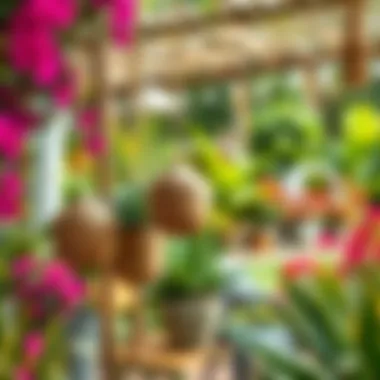
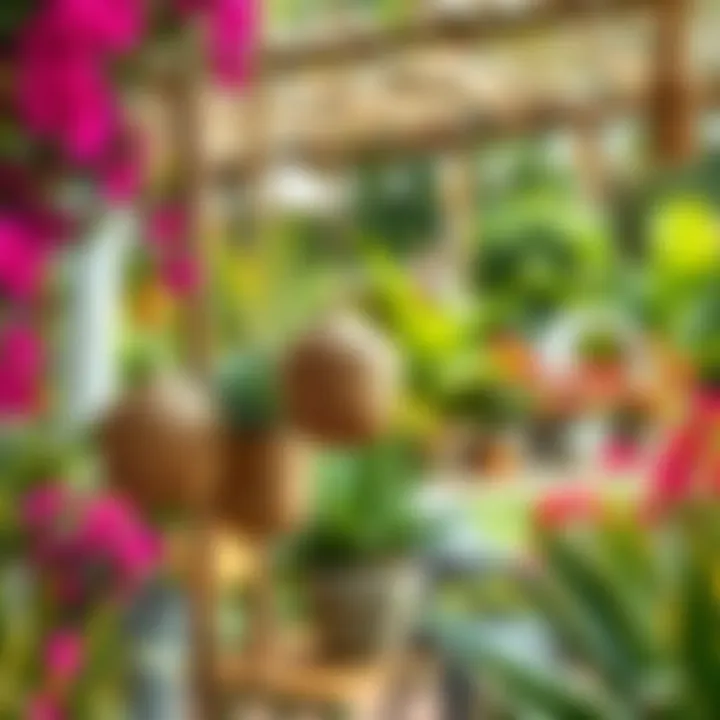
Being able to ensure that water can move freely through the planter aids in oxygenation for the roots – an often overlooked yet critical aspect of plant health. Improved drainage promotes stronger root growth, which is paramount for any plant, whether you are keeping them for aesthetic value or culinary purposes. The smoother transition of water through coco fibers makes it easier for roots to flourish.
"Choosing coconut husk hanging planters not only enriches your plant selection but also furthers a cause worth supporting: sustainability and environmental stewardship."
By examining the myriad benefits of coconut husk hanging planters, you discover a versatile option that appeals not just to the eye but works harmoniously with our planet. This blend of sustainability, plant health, and aesthetic appeal creates a win-win for anyone looking to green their space.
Crafting Coconut Husk Hanging Planters
Crafting coconut husk hanging planters is a remarkable blend of creativity and sustainability. This section is paramount as it guides enthusiasts through not only creating visually appealing planters but also emphasizes the utilization of an eco-friendly material that resonates well with the increasing trends in sustainable gardening. Using coconut husk as a medium provides a unique aesthetic that enhances any space, while also offering practical benefits for plant growth.
Materials Required
Before embarking on the crafting journey, gathering the right materials is essential. You’ll need:
- Coconut husk: The star of the show, coconut husk is not just a sustainable option; it is also lightweight and breathable, promoting healthy root development.
- Twine or sturdy string: This is for hanging your planter and must be durable to support the weight.
- Scissors or a sharp knife: Necessary for cutting the husk into the desired shape.
- Drill with a small bit (optional): Helps in creating drainage holes if they aren’t already present in the husk.
- Potting mix or soil: Essential for your plants to thrive while in the planter.
Having these materials on hand makes the crafting process straightforward and enjoyable, embodying both simplicity and eco-consciousness.
Step-by-Step Construction Process
Cutting the husk
When it comes to cutting the husk, precision is key. Start by selecting a piece of coconut husk that is thick enough to retain its shape but not too bulky to wield. Cutting involves slicing the husk open, ideally through its natural seams, to create a hollow space for planting. This method preserves the integrity of the fibers, providing support for the planter's structure.
The major advantage of properly cut coconut husk is its ability to maintain moisture while allowing for aeration, thus nurturing the plants' roots effectively. Furthermore, the unique texture provides a rustic charm that resonates particularly well with those who appreciate natural aesthetics in their indoor or outdoor gardening.
Shaping the planter
Shaping is where creativity flourishes. Once you have a portion of husk cut open, the next step is to form it into a desired planter shape. Use your hands to mold the husk into either a bowl or a hanging basket style, depending on what suits your vision best.
This step is crucial, as it determines how the planter will hang and the overall appearance. The natural curves of the coconut husk lend themselves beautifully to organic patterns. A noteworthy benefit of shaping the planter this way is that it reinforces the durability of the planter—allowing it to withstand both indoor and outdoor elements without deteriorating quickly.
Securing the hanger
Securing the hanger is the last step that brings your creation to life. Depending on the design, the twine or string can be threaded through a secure point on the planter, creating a reliable loop for hanging. Make sure to tie double knots to ensure the planter is safe and sound wherever it is displayed.
The importance of this step cannot be overstated. A well-secured hanger means that the planter won't just hang in the air but will also support the weight of the soil and plants contained within. Plus, a good hanging system adds an element of visual flair—drawing the eye upwards and accentuating any space it occupies.
Design Variations and Styles
Diving deeper into the aesthetics, coconut husk planters can be tailored to fit various design preferences and styles.
Traditional vs. modern designs
There’s a distinct charm in traditional designs that often reflect function meets artistry. These planters typically utilize the natural view of the husk with minimal alterations. In contrast, modern designs might incorporate geometric shapes and vibrant colors, appealing to a varied audience. Adapting traditional elements into contemporary settings not only speaks to your creativity but also allows for harmonious integration into almost any decor style. Traditional style conveys a grounded sense of nature, while modern interpretations can become bold focal points enhancing interior or exterior environments.
Customization options
Customization opens up a realm of possibilities. Whether it’s adding paint, embellishments, or even integrating additional materials like metal or wood, personalized touches make your planter unique. This not only strengthens the connection you have with your planter but also allows it to reflect your personality.
Furthermore, many people enjoy the art of creating themed planters—say, a tropical setup with colorful orchids and vibrant paint schemes, or a minimalist design featuring air plants. By bending the rules of design, you instill life and character into your hanging planters, ensuring they remain a point of conversation and admiration.
Choosing the Right Plants for Coconut Husk Hanging Planters
Selecting the right plants for coconut husk hanging planters is crucial. This decision influences both the aesthetic and functionality of your indoor or outdoor space. Proper plant choices can lead to flourishing greenery and a garden that teems with life. Different plants not only add various shades and textures but also bring about unique growing requirements and characteristics, which can complement the coconut husk planters perfectly.
Best Plant Varieties
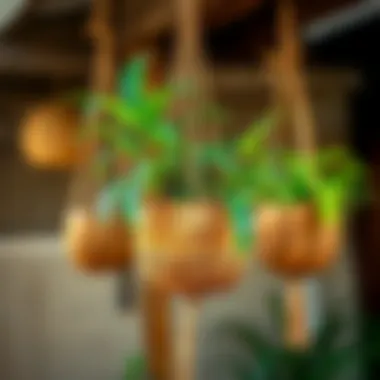
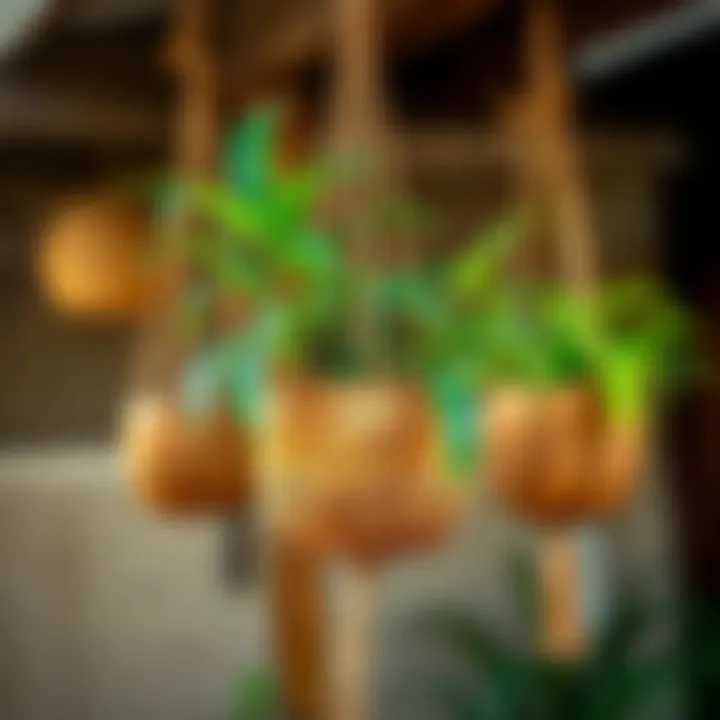
Succulents
Succulents are a top-tier pick when considering plants for coconut husk hanging planters. Their most notable characteristic is their exceptional ability to store water in their leaves, making them incredibly resilient to dry conditions. This trait aligns well with the porous nature of coconut husk, which allows for proper air circulation while still retaining some moisture.
The unique feature of succulents is their vast variety. From Echeveria to Haworthia, each type brings its own design flair, whether it’s the rosette shape of an Echeveria or the spiky appearance of an Aloe Vera. Their requirement for minimal water makes them a favorable choice for individuals who may not have a green thumb. However, one must be cautious not to overwater as this could lead to rot, particularly in the confined space of a hanging planter.
Ferns
Ferns are another excellent choice for coconut husk hanging planters. They thrive in humidity and shade, making them a perfect companion for indoor areas or shaded outdoor spots. Their lacy fronds can drape elegantly, adding texture and depth to a space.
One of their key characteristics is their adaptability; ferns can flourish in various conditions, although they prefer indirect sunlight. Moreover, they can tolerate occasional neglect, which makes them appealing for busy gardeners. On the downside, many ferns dislike dry conditions, so maintaining humidity becomes critical if one opts for these lush green plants.
Flowering Plants
Flowering plants undoubtedly add a splash of color to coconut husk hanging planters. Varieties such as Petunias or Lobelias are excellent for providing vibrant blooms that can attract butterflies and enhance the garden's visual appeal. The vibrant hues and fragrant scents can significantly improve the ambiance of an outdoor space.
Their primary charm lies in their seasonal display of flowers which can transform a simple hanging planter into a focal point. Flowering plants often have varied light and water requirements, which can differ greatly from succulents and ferns, so it’s essential to gauge the specific needs of each type. Some can be more demanding regarding sunlight and water, posing a challenge when combining them in a mixed planter setup.
Considerations for Light and Water Needs
When choosing plants for coconut husk hanging planters, understanding their light and water needs can make all the difference. Each plant species has its preferences for exposure to light, and pairing conflicting needs can stunt growth or lead to plant failure. Additionally, water requirements vary from one type to another. If a succulent, for instance, is placed next to a fern, the latter will likely thrive while the former suffers due to overwatering.
Thus, before making a selection, assess the light conditions of the planter's placement:
- Full sunlight: Ideal for succulents and certain flowering plants.
- Partial shade: Favorable for ferns and some flowering varieties.
- Low light: Often works for specific indoor plants or certain perennial types.
In summary, being mindful of the harmony in plant choices, specifically focusing on their light and water requirements, can greatly enhance the success of using coconut husk hanging planters. This ensures that plants not only survive but thrive, adding both beauty and environmental benefits to the space.
Placement and Maintenance of Hanging Planters
Placement and maintenance play a crucial role in maximizing the benefits of coconut husk hanging planters. An attractive planter not only showcase plants beautifully but also aids their growth. Selecting the appropriate location and providing ongoing care fosters a thriving green environment.
Best Locations for Display
When it comes to placing coconut husk hanging planters, light and access are essential factors to consider. Here are a few pointers:
- Bright, indirect sunlight: Most plants prefer filtered light. Hanging them near a window where sunlight cascades but does not directly scorch the leaves can promote healthy growth.
- Air circulation: Hang planters in places where they can enjoy a breeze. Good airflow around the foliage helps to prevent mold and stagnant air, both of which can adversely affect plant health.
- Height considerations: It's better to hang planters at eye level or higher. Not only does this make them more visually appealing, but it also reduces the risk of pets or children tampering with them.
In a nutshell, the right balance of light and airflow can give your plants the competitive edge they need to flourish.
Watering and Nutrient Requirements
Proper hydration and nutrition are vital for plants in coconut husk hanging planters. Here’s what you should keep in mind:
- Watering frequency: Unlike traditional soil, coconut husk holds moisture well, so you might not need to water as often as you think. It’s generally advisable to check the moisture level by sticking a finger into the husk. If it feels dry an inch down, it’s time to water.
- Avoid overwatering: Keep an eye out for signs of soggy husk or yellowing leaves, as these could indicate overwatering. Good drainage is a strong point of coconut husk, so ensure that drainage holes are unclogged.
- Fertilizing needs: Use a balanced liquid fertilizer at half strength every four to six weeks. The organic matter in coconut husk provides a decent amount of nutrients, but supplemental feeding aids in sustaining plant growth.
Remember, establishing a routine will help you maintain a healthy planting environment while preventing any mishaps.
Pest Management and Health Monitoring
Even the most robust plants can fall victim to pests if not monitored closely. Here’s how to stay on top of pest management:
- Regular inspections: Establish a routine for checking your hanging plants. Look closely at the leaves for any signs of insects or discoloration. Early detection is key to preventing infestations.
- Natural deterrents: If you catch a leaf-gnawing bug, consider using natural pest control methods. Insecticidal soap or neem oil can be effective without dousing the plant in harsh chemicals.
- Quarantine and treatment: Should you find a pest infestation, isolate the affected plant. Treat it before reintroducing it to your hanging arrangements. This simple step can save the rest of your collection from an unwanted attack.
"The art of maintaining plants in coconut husk hanging planters relies on vigilance, care, and proper techniques to keep them thriving."
Through thoughtful placement and diligent maintenance, your coconut husk hanging planters can transform your living space while providing a flourishing home for your green companions. Proper care creates a symbiotic relationship between you and your plants, amplifying the aesthetic and environmental benefits of these unique planters.
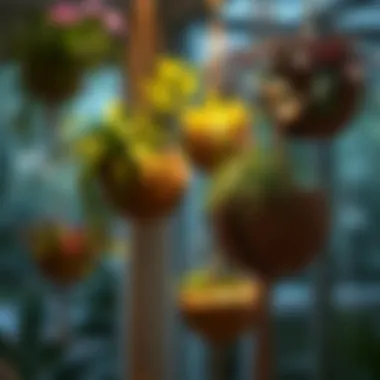

Coconut Husk Planters in Interior Design
Coconut husk hanging planters are more than just a gardening solution; they represent a blend of nature and art that can transform indoor spaces. In modern design, incorporating natural elements is not merely a trend but a significant aspect of creating a harmonious living environment. The unique texture and rich color of coconut husk not only add visual interest but also bring a slice of the tropical outdoors inside, making them a perfect fit for various design aesthetics.
Incorporating Planters into Home Aesthetics
When integrating coconut husk hanging planters into home aesthetics, consider the overall style and color palette of the space. These planters, due to their earthy tones and natural fibers, can complement various interior themes, such as bohemian, rustic, and even industrial. Here are some effective ways to incorporate them:
- Layering Textures: Combine coconut husk planters with other materials like ceramics or metal to create depth. For instance, hanging a planter made from coconut husk beside a sleek metal sculpture can produce a striking contrast.
- Color Coordination: Match the plants’ foliage to the room’s color scheme. Bright greens can energize a neutral space, while dark foliage could lend an air of sophistication.
- Strategic Placement: Think about heights and sightlines. Hanging these planters at varying levels can draw the eye upward, emphasizing the verticality of a room and making it feel more spacious.
It's essential to ensure that the plants chosen for the coconut husk hangers not only fit the aesthetic but also thrive in the light conditions of the interior space. Creeping plants, such as string of pearls or pothos, create a beautiful cascade, softening sharp architectural lines.
Examples of Effective Displays
A well-designed display can turn simple greenery into a statement piece. Consider these practical implementations:
- Kitchen Herb Garden: Hang several coconut husk planters in the kitchen, filled with assorted herbs. This setup is not only functional but adds lively greenery and a fresh vibe to culinary spaces.
- Entryway Warmth: Utilize larger husk planters near the entrance. Filling them with trailing plants like philodendrons can create a welcoming environment that invites guests in.
- Living Room Focal Point: Create a dramatic focal point by suspending a cluster of coconut husk planters at different heights over a seating area. This setup could house a mix of flowering plants and succulents, adding warmth and a touch of whimsy.
"The right plants not only breathe life into your space but can also significantly influence mood and well-being."
Environmental Impacts of Coconut Husk Planters
The conversation around coconut husk hanging planters not only touches on their aesthetic appeal but also delves into their environmental significance. The impact that these planters have on ecological sustainability is crucial, especially in a world grappling with excessive plastic usage and deforestation. By exploring this dimension, we can appreciate the dual role these planters play: they enhance surroundings while conversely ameliorating environmental impacts.
Sustainability and Resource Utilization
Coconut husks, a byproduct of coconut production, are a prime example of sustainable resource utilization. The journey from coconut tree to your gardening project is a testament to circular economy principles. When these husks are repurposed into planters, they serve a dual function—reducing waste and offering a natural growing medium that is biodegradable.
Key points of sustainability in coconut husk planters:
- Biodegradable Nature: Unlike most modern materials that end up in landfills, coconut husk decomposes naturally, enriching the soil over time. This characteristic makes it an eco-friendly option for plant enthusiasts who are conscious of their environmental footprint.
- Low Carbon Footprint: The process of creating coconut husk planters requires minimal energy, particularly when compared to synthetic materials. People can contribute to lower carbon emissions simply by choosing natural over manufactured.
- Promotes Diversity: Utilizing coconut husks opens the door for the growth of various plants, thereby promoting biodiversity. Organic growers can select plants that thrive in this medium, increasing flora variety in households and communities.
By choosing coconut husk planters, individuals are becoming stewards of the environment, making conscientious choices that align with eco-friendly living.
Comparative Analysis with Other Materials
In the landscape of gardening materials, coconut husk planters stack up quite well against traditional alternatives. While items like plastic, clay, or ceramic pots have their own merits, they often come with their fair share of environmental downsides. Here, we’ll compare coconut husks to these popular options to highlight their distinct advantages.
- Plastic Pots: While plastic pots are lightweight and cheap, they tend to be non-degradable, often contributing to the growing problem of ocean and land pollution. In contrast, coconut husks vanish back into the earth, mitigating waste.
- Clay and Ceramic Pots: These options can be aesthetically pleasing and durable, but their production involves significant energy, contributing to a larger carbon footprint. Furthermore, if broken, they don't decompose. Coconut husk planters, however, offer a versatile design and are lightweight, which facilitates easier handling and installation.
- Wooden Planters: Often seen as a rustic choice, wooden planters require sustainable, sourced timber and can decay over time. Coconut husks, on the other hand, provide a robust and long-lasting alternative without the need for deforestation.
By considering coconut husks against other materials, it’s clear that they present a compelling case for environmentally responsible gardening practices. As consumers shift toward greener choices, integrating coconut husk planters could help nurture an earth-friendlier approach to landscaping, while beautifully adorning spaces with flourishing plants.
"The simplest acts of stewardship can lead to profound changes in the environment and our lives. Every choice with coconut husk planters supports a healthier planet."
To dive deeper into the impact of gardening materials on the environment, you can explore related topics at Wikipedia and Britannica. Understanding the benefits of coconut husk planters makes us not just homeowners, but responsible caretakers of our earth.
Culmination: The Versatile Role of Coconut Husk Hanging Planters
Coconut husk hanging planters have carved out a significant niche in the realm of gardening and interior design. Their unique qualities not only enhance the aesthetic appeal of spaces but also bring practical advantages that gardeners of all levels appreciate. Engaging with these planters goes beyond simple gardening; it reflects a commitment to sustainability, creativity, and an eye for beauty.
In this article, we’ve delved deep into the essentials of coconut husk planters, showcasing their durability, eco-friendliness, and ability to retain moisture while promoting healthy plant growth. These planters serve as ideal containers for a variety of plant species, accommodating both succulents and flowering plants, and thus catering to a broad audience of plant enthusiasts. Furthermore, their natural composition allows them to blend harmoniously with diverse design aesthetics, ranging from rustic to modern.
Summary of Key Insights
- Sustainable Choice: Utilizing coconut husks aligns well with environmental stewardship, making it an appealing option for eco-conscious consumers.
- Aesthetic Versatility: The organic texture and color of coconut husk add charm to both indoor and outdoor settings.
- Practicality: Features such as excellent drainage and moisture retention make these planters suitable for various plant types, ensuring their longevity and the health of the plants within.
- Crafting Opportunities: The hands-on process of creating these planters opens up avenues for customization, allowing individuals to express their personal style while gardening.
As we look ahead, the coconut husk hanging planter can only become more popular, thanks to the growing awareness surrounding eco-friendly practices and the increasing pursuit of unique home aesthetics.
Future Trends in Planting Solutions
The gardening landscape is continuously evolving. Here are some trends predicted to shape the future of coconut husk hanging planters:
- Integration of Technology: Innovations, such as self-watering systems, may find their way into coconut husk planters, making plant care even easier.
- Sustainable Practices: As consumers become more discerning, the demand for ethically sourced materials will rise, prompting even more creativity in planter design and usage.
- Community and Sharing: There’s likely to be an uptick in workshops and shared spaces where individuals can learn about crafting coconut husk planters, fostering a sense of community and education.
- Eclectic Plant Pairings: With a growing interest in biophilic design, expect to see more adventurous plant combinations being presented in these planters, encouraging a playful exploration of greenery.
In summary, coconut husk hanging planters marry function with form, presenting gardeners and design aficionados alike with a sustainable, artistic, and rewarding way to engage with nature. By embracing this innovative planting medium, you not only elevate your green spaces but also contribute to a greener planet.



